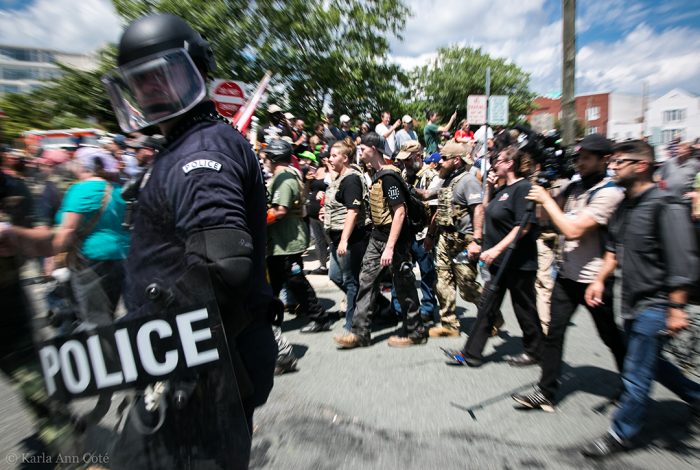
But the whole nation has a stake in a related matter, the inaction of the local police.
The Charlottesville Police Department was not caught unawares. It had anticipated a crowd of from 2,000 to 6,000 people, and had promised a presence with assistance from the Virginia State Police.
Yet when violence and bloodshed broke out at Emancipation Park, witnesses complained to the New York Times that “There was no police presence…. We were watching people punch each other; people were bleeding all the while police were inside of barricades at the park, watching.”
A.C. Thompson, a reporter for ProPublica, saw repeated instances of this police inertia:
At about 10 a.m. [August 12], at one of countless such confrontations, an angry mob of white supremacists formed a battle line across from a group of counter-protesters, many of them older and gray-haired, who had gathered near a church parking lot. On command from their leader, the young men charged and pummeled their ideological foes with abandon. One woman was hurled to the pavement, and the blood from her bruised head was instantly visible. Standing nearby, an assortment of Virginia State Police troopers and Charlottesville police wearing protective gear watched silently from behind an array of metal barricades — and did nothing. It was a scene that played out over and over in Charlottesville as law enforcement confronted the largest public gathering of white supremacists in decades. We walked the streets beginning in the early morning hours and repeatedly witnessed instances in which authorities took a largely laissez faire approach, allowing white supremacists and counter-protesters to physically battle.
This bizarre police inaction in a threatened liberal city replicated the behavior of the Berkeley police at similar right-wing provocations in February and April of this year.
I myself was a witness as the UC Berkeley police calmly watched agitators throw rocks and set fires during a February 1 campus protest against alt-right provocateur Milo Yiannopoulos. Later, “a UC Berkeley police sergeant who was on duty at the protestdenied allegations on social media and other various media outlets that police were told to stand down and do nothing.”
Two months later, Ann Coulter followed Yiannopoulos in a second failed attempt to speak at UC Berkeley. This time demonstrators were forced to relocate to a downtown city park. There, according to an alt-right website, supremacists “came ready and willing to literally, physically fight for the Constitutional rights of all Americans.” Nathan Damigo, a white supremacist among them “captured on video … punching a woman in the face,” has now been “credited with helping to lead the Charlottesville protest.”
After the April 17 event, the Berkeley City Police, like the UC Berkeley police, were criticized for their inaction. In the words of one reporter,
“The blatant violence, which sent at least seven people to the hospital, including one who had been stabbed, left some wondering: Where were the police in all this?”
Policing has become a highly controversial profession in recent years, especially since the 2014 shooting of an unarmed black man in Ferguson, Missouri. In Berkeley, both the campus and the city police had previously been faulted for intervening too energetically. In particular, a 2014 Black Lives Matter protest where officers used tear gas “prompted a wave of public outrage that went on for months and caused the [city] department to devote extensive resources to its own analysis of what happened.” An ensuing lawsuit law led police to reconsider their intervention strategy.
The reluctance of police to intervene since then has been a matter of revised police department policy. After the Yiannopoulos incident, Berkeley Campus Police Chief Margo Bennett told the Los Angeles Times that moving officers into the melee would have created “a lethal, horror situation…. We have to do exactly what we did last night: to show tremendous restraint.”
Georges Clemenceau once said famously that “War is too serious a matter to entrust to military men.” In America’s current political crisis, a similar observation could be made about organized public violence and police officers. It is time for the public to consider how there can be wider involvement in the obviously political decisions of how much disruption policemen should tolerate, before they intervene.
Source: https://whowhatwhy.org/2017/08/14/charlottesville-police-inaction-part-nationwide-development/
38 Comments on “CHARLOTTESVILLE POLICE INACTION: PART OF A NATIONWIDE DEVELOPMENT”
Comments are closed.